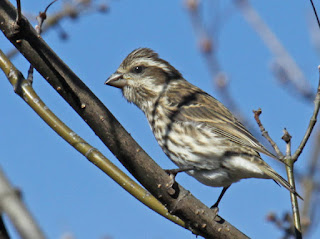When the morning weather reporter forecast sunny skies and temperature pushing 60-degrees, Tom and I decided to head down the Mississippi - on the Minnesota side - to check out the Tundra Swan migration.
First stop, just north of Minneiska on US 61 - Great River Road.
We pulled off the road and parked at St. Mary's Cemetery. That's where we saw 200+ swans and a thousand or more coots. Too far away for a photograph. I resisted the temptation to cross the highway and railroad tracks to get closer.
Instead, we got back in the car and headed south to Brownsville (south of La Crescent, MN). We spotted the first rafts of swans just south of the Shellhorn Bar and Grill on MN State Rd 26. A mile further down the road, we got our closest looks - at the Upper Mississippi National Wildlife and Fish Refuge new Brownsville Overlook.

According to the Refuge fall waterfowl aerial survey report for October 25, there were 10 Tundra Swans on the river. Today there were several thousand, along with thousands of ducks, coots and Canada Geese.
On the way back home we stopped to check out the waterfowl on the Wisconsin side of the river - at Cedar Ridge Resort in Nelson and Rieck's Lake Park in Alma. We spotted a handful of swans and several rafts of waterfowl way off in the distance at Cedar Ridge (please stop by the front desk at Cedar Ridge and ask Wes Stensland for permission before you drive down to the river) and a few swans way off in the distance at the Rieck's Lake Park observation deck.
We got a better (but not great) look at a dozen swans in the lake by the Tell Church on State Road 37 (south and east of Rieck's Lake Park on the Buffalo River).
By the time we found these swans, the sun was setting.
-----------------
Now's the time to head down river to see waterfowl. If you're interested in a guided tour, the Refuge is sponsoring a SwanWatch bus tour ($20/person - lunch included) on Saturday, November 13 (9am-3pm) departing from Winona. To reserve a seat, call Ed Lagace (before November 6) at 507-494-2636.
Refuge volunteers will be at the Brownsville Observation Deck to help answer questions every weekend (10am to 4pm) in November.
Dress for cold, windy weather. If it's too cold, you can see the swans from your car at Brownsville. The bird action is best early in the morning and late in the afternoon.
Click here (and scroll down) for a sample of what you'll hear...




































